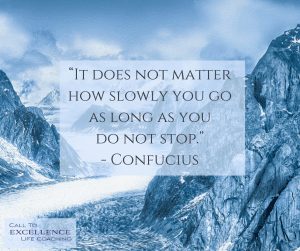
I used to think I needed to set aside large chunks of time to tackle big projects. If I was going to write, I needed an entire weekend free, or at least a full day. If I was going to reorganize my closet or clean my garage, I needed to do it all in one session. If I wanted to get into shape, I needed to spend hours in the gym every single day.
I don’t think I’m alone in this all-or-nothing thinking.
I talk to a lot of people who have been procrastinating on a particular project or goal for ages because they’re waiting for a large enough chunk of time to magically appear on their calendar to give them the space to finally devote themselves to getting whatever it is done.
The problem is, in our over-scheduled, over-committed lives, these tropical islands of free time rarely make an appearance. And if one does, we frequently discover that our motivation to work on that particular project has gone AWOL. Or, we can’t work up the energy. Or some other more appealing opportunity presents itself.
The truth is, when we procrastinate, there’s usually some type of internal resistance in addition to the external time constraints. Maybe it’s dread of the task itself (does anyone really enjoy cleaning their garage?), or maybe there’s some subconscious fear or self-doubt.
The good news is, it doesn’t matter what your calendar looks like, or what’s blocking you. Approaching these types of projects with a kaizen mindset – consistently putting in small increments of time –circumvents both the calendar constraints and the mental blocks.
The Snowball Effect of Kaizen
When I first tell people about this application of kaizen – getting big projects done in tiny segments of time, they usually dismiss it as being too simple. I mean, how can 5 minutes or even 15 minutes a day possibly make any difference, considering the enormity of our goal or challenge?
I mean, organizing a closet takes at least 3-4 hours, and cleaning out the garage is at least a 6-8 hour job. Never mind how much time it takes to write a book, or get the education you need for a promotion or a career change, or start your own business…
Tiny time increments won’t even make a dent…
What people who dismiss kaizen overlook is the power of the snowball effect.
If you’ve ever made a snowman (snow person?), you know you start with a small ball of packed snow. You add some more snow, pack it together, and then pile on a little more. Maybe you roll it along the ground, and with every inch it picks up a little more snow.
Each handful of snow isn’t much on its own, but over time it accumulates, and pretty soon you have an enormous ball
Time works in much the same way.
Time Snowballs
Small increments of time add up.
It sounds obvious, but most people don’t recognize the real power or magnitude of this truth.
Let’s do a little math:
- Five minutes on a project daily equals 35 minutes a week, 2 hours and 20 minutes a month, and 28 hours over the course of a year. That’s plenty of time for most projects.
- If you can spend 15 minutes a day, that’s nearly 2 hours a week, 7 hours a month, and 84 hours a year. That’s the equivalent of two full time work weeks.
- Let’s say you can dedicate 30 minutes every day. All of a sudden you’ve put in 3.5 hours in a week, 14 hours in a month, and 168 hours over the course of a year. That’s like taking an entire month off from your day job to dedicate to your project.
The “magic” is in consistency.
All we have to do is set aside a tiny amount of time to work on a particular goal or project, every day.
Every tiny time increment adds to the ones that came before, and every tiny step builds on the previous steps.
But It’s Going to Take Forever …
This is where people usually get hung up. They understand the math, but they think it’s going to take too long to see their little time snowball grow into anything significant.
First, to be blunt, consistently putting in 5 minutes a day is going to move your project forward much farther than procrastinating and thinking about it for months or even years. Just suspend your skepticism for a week and give it a try.
I think you’ll be surprised at how much you accomplish even in that short amount of time… and at how easy it was.
Second, the great thing about a kaizen approach is that you’ll actually start to see progress immediately. Every single day. And progress feels good.
Even after your first 5-minute session, you’ll feel a sense of relief and accomplishment that you’ve finally begun. After a few sessions, you’ll start to see visible progress.
Does Kaizen Really Work?
Unequivocally, yes.
I’ve used the 5-minutes-a-day approach to clear out file boxes of paper clutter, declutter my home, read through my backlog of books and magazines, and tackle cleaning projects. Using 10- or 15-minute-a-day time chunks, I crushed my personal to-do list, and now I’m working on taming my overflowing email inbox.
To give you a specific example, I recently used this approach to tackle several piles of paper clutter I had been avoiding for a long, long time. Every time I saw the stacks, my brain would just shut down. They were a major distraction and eyesore. I needed to deal with them, but I knew organizing those piles was going to take an enormous amount of mental energy, and that thought depressed me. So even when I had a chunk of time, I kept putting it off.
Finally, I decided to commit 5 minutes a day. I mean, no matter how mentally taxing it was, I could survive 5 minutes. Every evening, I’d set the timer on my phone, pick a stack, and get to work. Some days, I only filed away an article or two. Other days, I shredded batches of old bills or notes that were no longer relevant.
I’d been at it for a little over 2 weeks when I looked around and noticed that I’d run out of piles. I was honestly in shock. I thought it would take months, and suddenly… I was almost finished!
Obviously, some projects will take longer to complete, especially if you’re creating something, like writing a book. But you’ll still see progress quickly. Using writing a book as an example, after every session, you’re going to have added more words to your draft, or fleshed out more of the outline or character sketches, or deepened your research. The idea you had been holding in your head for so long will finally be starting to take shape in the real world.
Why 5 Minutes?
Five minutes, no matter how much you hate a task, is an amount of time almost everyone can tolerate. And no one is so busy that they can’t carve out 5 minutes from their schedule every day.
But there’s no magic in the number 5. The key is finding an amount of time that’s well below your pain threshold, and that you can easily fit into your schedule every single day, no excuses. For some projects, maybe 10 or 15 minutes is a comfortable amount of time. If you truly can’t find a spare 5 minutes in your day, or working on a particular task makes a root canal sound appealing, go with 1 or 2 minutes.
Just pick a time segment that you find it easy to commit to on a daily basis.
Remember, no matter how slowly you move forward, you’re going to go faster than standing still.
Your Kaizen Challenge:
First, let go of the mindset that says you have to do it all at once. It’s not true, and it’s been holding you back.
Second, pick a project you’ve been procrastinating on. Think about how much time you’ve already wasted by putting it off. Commit to working on it for 5 minutes every day for a week.
After a week, evaluate how your kaizen experiment is going:
- Is 5 minutes a day feasible? Or did you find yourself forgetting or making excuses? If so, try backing off to 1 or 2 minutes. Or did you find yourself working on your project for longer than 5 minutes, once you got started?
- Have you made a dent in your project? Can you see your snowball starting to grow?
- Do you feel better now that you’re moving forward?
- Is this approach something you can continue?
I’d love to hear about your results – let me know how your experiment goes in the comments below! For more on using kaizen to get yourself unstuck, read my recent post, “Getting Unstuck: Kaizen and the Magic Geranium.” And stay tuned for my next post on how kaizen works to create “Motivation Snowballs”!







14 thoughts on “Overcoming Procrastination: Using Kaizen to Create Time Snowballs”
Enjoying your posts on Kaizen. It’s definitely appropriate for me right now. Thanks for the inspiration!
Thanks Heather! So glad you’re finding this series helpful – the general concept of kaizen is incredibly practical and you can apply it to just about anything 🙂
I really like this. I’m an expert procrastinator so will definitely be giving this a go.
Thanks Dane! I hope it helps – using this approach has definitely had a positive impact on my life 🙂
I loved this post! It’s almost like you were speaking directly to me. I have a terrible problem of procrastinating but I’m trying to get better. I love this approach and will get to work on it immediately. The only problem is trying to decide which mess to tackle first! Thanks for the inspiration!
Thanks Sheri! I was a champion procrastinator too, and taking a kaizen approach has really helped me move forward on a lot of projects. As for which mess to tackle first, check out my post on Getting Unstuck and the Magic Geranium (http://calltoexcellence.com/kaizen-and-the-magic-geranium/). Basically, it doesn’t matter where you start, any place is the right place 🙂 Just pick one and get going, and the momentum will carry over to the other trouble spots 🙂
I enjoyed this post. I can relate to this and want to use this approach with several projects I need to do around the house and organizing photos and files. Thank you for sharing.
Thank you! Yes, the kaizen approach is perfect for projects like organizing photos or files – projects that seem too overwhelming to tackle in one session, so they just keep getting put off. Even if you just organize one photo or file a day, you’ll be amazed at how quickly it gets done 🙂
This is super helpful! I have a tendency to let paper clutter and digital clutter (aka emails) pile up and then it just seems too overwhelming to even look at. I also have a tendency to let work tasks (like grading papers) pile up for weeks and I’m paying for it now. When I do have a few spare minutes, I usually just surf the net because it seemed like such an insignificant amount of time that why even bother, but you totally changed my perspective!
Thanks Kate! So glad this changed your perspective! I used to do the same thing – I’d waste time on the internet or playing on FB, but then I realized how much time I was wasting and how much I could get done if I put it to better use. The key is planning ahead, and having something ready to go for when you have a few free moments – grading papers is perfect – if they’re easily accessible, you could probably get one done when you have a 5 minute slot of time, and then another when you have a few more minutes. All of a sudden that backlog is gone 🙂 Good luck!
When you do the calculation from the time snowballs, the add up total is quite bizzare. Everyday passes so quickily and if we can just spend 15-20 mins, the effect or the result can be very big. We are building big things out from just 20 mins a day. 20 min is not really that much in day. You math example really convincing. Very inspiring and motivating post.
Thank you! The math is definitely both sobering and inspiring, depending on how you’re using those 15-20 minutes. We can definitely accomplish big goals in small daily chunks of time – the key is consistency 🙂
my desk is a mess and I’ve been trying to do a little bit at a time in manageable chunks but as you said “the magic is in the consistency” that’s really the secret. I get busy with work and it goes back to being messy. I just need to try again!
Yes, consistency is really the key – you’re on the right track with tackling the desk clutter, just give it another try! Even if you slip with the consistency, get back to it as soon as you can, and that will help to create a new habit 🙂